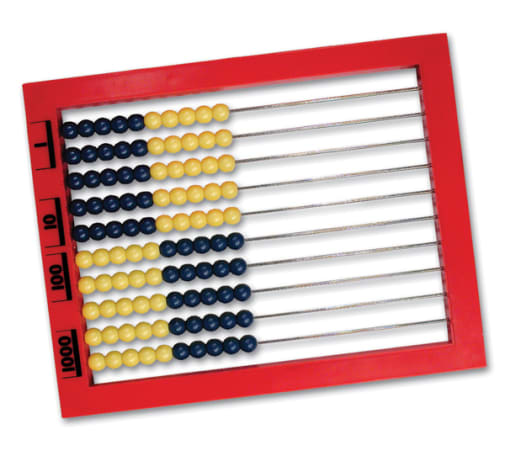A side-to-side plastic bead abacus. There are 10 wire rows of 10 beads each on a 9" x 8" plastic frame. The most helpful feature of the abacus is the use of blue and yellow colored beads -there are 5 of each color per row- which makes it more effective for all operations.
Abacus, Side-to-side, Blue and Yellow
- Small parts. Not for children under 3 years.
Description
This abacus features a frame that is thicker than the beads, which allows abacus to lie flat on student desks. Abacus activities offer students tactile counting practice and visual reinforcement of math facts. Includes 10 rows of 10 beads in 2 colors grouped in fives for ease of use. Abacus measures 8 1/2" L x 9 1/2" W x 1/2" H.
Based on research comparing the differences between Japanese first grades and first grade classrooms in the U.S., the RightStart Mathematics curriculum incorporates certain aspects from Asian math programs such as non-counting strategies and an alternative number naming system. In this program, the student is taught to see quantities in groups of fives and tens. Asian words for numbers greater than 10 implicitly give you a feel for the base ten system. Literally translated, eleven is "ten-one," twelve is "ten-two," and so on. RightStart students learn to count the "math-way" before they are taught the less intuitive words for 11 to 19.
There are 10 major characteristics that make up the RightStart Math program:
- Refers to quantities of up to 3 as a group; does not count individually.
- Uses fingers to show quantities up to 10; teaches 6 to 10 as 5 plus a quantity.
- Avoids counting procedures for finding sums and remainders.
- Once quantities 1 to 10 are known, proceeds to 10 as a unit. Uses the "math way" of counting; say for example, "1-ten 1" for eleven, "1-ten 2" for twelve, "2-ten" for twenty, and "2-ten 5" for twenty-five.
- Uses expanded notation (overlapping) place-value cards for recording 10s and 1s
- Proceeds rapidly to hundreds and thousands and uses place-value cards. Provides opportunities for trading between ones and tens, tens and hundreds, and hundreds and thousands with manipulatives.
- Only after the above work, gives the traditional English names for quantities 20 to 99 and then 11 to 19.
- Teaches tens-based strategies for addition and subtraction facts that have a sum > 10. Teaches informal solutions and mental computation before written algorithmic work.
- Teaches four-digit addition and subtraction on the abacus; lets the children discover the paper and pencil algorithms.
- Short division precedes long division, which is taught in fourth grade.
In Level G, students continue to practice arithmetic, fractions and decimals, while they begin to also explore triangles, area, volume, ratios, Pythagorean Theorem, tiling, and other new concepts.
All RightStart Math levels require a lesson manual and worksheets, which are included in the starter kits. The worksheets are also available separately for multiple students. Lesson manuals contain detailed lesson plans with helpful diagrams and teaching notes. Both lesson manuals and worksheets are spiral-bound. Add-on kits allow you to move forward, buying only what you need in addition to what you already have for the next levels.
| Product Format: | Other |
|---|---|
| Grades: | K-8 |
| Brand: | Learning Resources |
| EAN/UPC: | 765023843354 |
| Length in Inches: | 7.5 |
| Width in Inches: | 10 |
| Height in Inches: | 1 |
| Weight in Pounds: | 0.55 |

